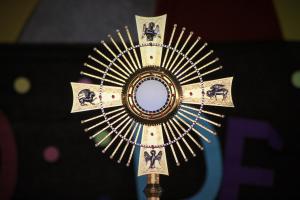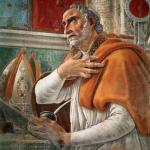
This is part of a series responding to the 100 most common questions people have about various religious traditions. In the case of Catholicism, naturally one of the things people want to know about is our belief regarding what we call the Eucharist and the question calls “communion.”
The terminology is important to clarify at the start. Most Protestants refer to the ceremony of praying over and sharing in bread and wine as “communion,” and there’s a reason for this which I’ll explain later. For Catholics, “communion” is part of the Eucharist but not our usual term for the whole act (though we do sometimes use it in that sense). We more often say “the Eucharist” or “the Sacrament of the Altar” or most commonly, for the whole service that includes Scripture reading and prayer and preaching as well as the Eucharist, “the Mass.”
The Eucharist is, for us, the “source and summit” of the Christian life. Jesus instituted it on the night before he died when he broke bread and poured wine and shared it with his disciples, telling them, “This is my body,” and “this is my blood.” Every day in Catholic churches around the world, priests repeat these words over bread and wine, and we believe that when this happens the bread and wine become the body and blood of Jesus.
Literal flesh and blood?
People often say that we believe that the bread and wine become the “literal” or “physical” body and blood of Jesus. Many Catholics say this too. But actually Church teaching isn’t quite so simple. As you can see from the link above, the Catechism of the Catholic Church uses words like “true” and “real” and “substantial,” but not “literal” or “physical.” Catholic apologists have historically defended the idea that Jesus’ words “this is my body” and “this is my blood” are “literal” rather than figurative. In other words, Jesus was really saying that the bread and wine become his body and blood, not just making a metaphorical statement about what they represent symbolically. There’s a range of opinion among Protestants about just what kind of “Real Presence” might be in the bread and wine, and some of those views come pretty close to Catholicism (Lutheran and Anglican views especially). But most Protestants think that we take the idea of “Real Presence” too far.
What do we really mean by it? As with the Trinity–the other great mystery of our faith, but shared by far more of our fellow Christians–we don’t claim to know exactly. We believe that Jesus–the whole Jesus, body, blood, soul and divinity–is truly and fully present under the “appearances” or “outward forms” of bread and wine. The problem I have with calling the Presence “literal” is that this gives the impression that the bread and wine become “body” and “blood” in the normal senses of those words. In other words, in a truly “literal” view we’re basically gnawing on hunks of bloody flesh but God mercifully fools our senses so that we aren’t grossed out by it. There are Catholics who think that way, but it’s not what the Church says and in my opinion it’s not a very good way to think about it.
It’s certainly not how the great theologian St. Thomas Aquinas talked about it. Aquinas says that Jesus’ body in its “natural dimensions” is in heaven. What he means by “natural dimensions” is basically what we would mean by a “physical” presence–something you can measure and examine with your senses or with scientific instruments and so on. Jesus was once present on earth in that way. But no longer. Now he is present “by way of substance.” He is not present “as in a place.” If you move the Host (the bread that has been consecrated and transformed into Jesus’ body and blood), Jesus’ body isn’t being moved. If you chew the Host (traditionally discouraged to be sure), Jesus’ body isn’t getting chewed up. If you were to trample on the Host, you would be, from a Catholic point of view, committing a terrible act of sacrilege (and you would be really upsetting all Catholics, so please don’t do that), but you wouldn’t actually be hurting Jesus at all.
Note that I said that the bread is transformed into Jesus’ body and blood. So is the wine. The bread doesn’t become flesh while the wine becomes blood. Every particle of both becomes the whole Jesus. (That’s why we can, and often do, receive only the Host–especially during the pandemic and other times of contagious disease. We aren’t getting any “less Jesus” when we do that.) And the Jesus who is fully and really present under the forms of bread and wine is the glorified Jesus with a transformed, risen body.
A new kind of reality
All of this can seem very weird and abstract. It’s weird to be sure. That’s a feature, not a bug. For us the Eucharist is a window into a new kind of reality–the reality of the “world to come” or the “Kingdom.” We speak of it as a “foretaste of the eschatological banquet.” The world into which Jesus calls us is a world where we will still have bodies but they will be radically transformed, as Jesus’ body was in the Resurrection. In Paul’s words (from 1 Corinthians 15), they will be “spiritual bodies,” which sounds to us like a contradiction in terms. It’s a paradox, like so much else in the Christian faith.
We don’t have the vocabulary or the concepts to describe this new, transformed kind of bodily reality. So we do the best we can. We try to use language that preserves the mystery instead of watering it down. That’s why we avoid saying things like “Jesus is spiritually present” or “it’s a profound symbol.” Those statements may well be true in some sense, but in our vocabulary here and now they make what is going on seem too safe. Yes, symbols can be profoundly real. Yes, what is going on in the Eucharist is the work of the Holy Spirit and is obviously “spiritual.” But to say “it’s just spiritual” or “it’s just a symbol” lets us breathe a sigh of relief and go on living in the “normal” world without fully reckoning with the radical challenge posed by the Incarnation to our definition of reality itself.
What does Aquinas mean by “substance”? He gets the term from Aristotle, though Aristotle would think what he was doing with it was very weird. For Aristotle, everything has a “substance” that makes it the kind of thing it is. This isn’t itself a physical, measurable thing. What we can observe and measure are the “accidents,” some of which are necessary “properties” of a thing and others may change over time. Now Aristotle would think it was nonsense to say that you can have the substance of body and blood without any of the accidents, or the accidents of bread and wine without the substance. So it’s not true to say, as many people do, that Aquinas just squeezed the doctrine into Aristotle’s framework. He took language and concepts from Aristotle, but they couldn’t hold the mystery. They broke. All language and concepts break when confronted with the Holy Mysteries. We’re still using this broken language from Aristotle because we haven’t found any other language that does a better job of letting the mystery shine through. That’s all.
The bottom line is this: for us Jesus is present in such a way that it is entirely appropriate, even necessary, to worship him in the Sacrament. We don’t just honor the Eucharist in the way that we would honor, say, the image of a saint or for that matter a crucifix that reminds us of Jesus’ sacrifice. No, we believe that the whole Jesus, human and divine, is present under the forms of bread and wine, and we worship Jesus in that form in the fullest sense of the word. That’s the ultimate dividing point between a Catholic theology of the Eucharist and a Protestant one. We can parse out the metaphysics till we are weary, but the real question is: do you worship or not?
Sacrifice and Communion
Now back to why Protestants are more likely than Catholics to call the Eucharist “Communion.” The Protestant Reformation, the people who would become “Protestants” criticized medieval Catholicism for seeing the Eucharist as a sacrifice. In the late Middle Ages, most laypeople didn’t receive communion more than once a year–three times was considered quite frequent and a sign of great devotion. More than that was suspect–how holy did you think you were to be worthy of receiving communion so often? And when laypeople did receive, they only received the Host, not the Cup.
So for most medieval Catholics, the Eucharist wasn’t primarily about receiving communion. It was a sacrifice offered by the priest, and they participated by saying their own prayers as the priest was praying and then by worshiping Christ in the Sacrament as the priest lifted the Host above his head at the moment of consecration. There were lots of folk beliefs about the benefit of seeing the “elevation” of the Host. In fact, in cathedrals and large churches multiple Masses would be celebrated at the same time and people would allegedly run around the church to see the Elevation as often as possible, much to the annoyance of preachers who wanted them to sit still and listen.
Both Luther and Calvin wanted people to receive communion more often, though they weren’t successful in getting them to do this. But Protestants weren’t willing to celebrate the Eucharist if people weren’t ready to receive. This was because for Protestants the only point of the Eucharist was communion. Thus, Protestants wound up celebrating the Eucharist only a few times a year, not because they didn’t think it was important, but because they didn’t believe in a Eucharist at which only the person celebrating received communion (which was at that time the norm in the Catholic church).
For Catholics, on the other hand, the Eucharist is still the Eucharist even if only the priest receives. For one thing, in our view every Eucharist is fundamentally the same act. The entire host of heaven, all the saints and angels, are present at every Mass. It’s the same Jesus present on every altar in all his fullness. The Mass breaks down the divisions of place and time, so it would be silly to say that it’s not really a Mass just because only one person at that particular place and time was receiving communion.
Not only is every Mass deeply connected to every other Mass, but every Mass is deeply connected to Jesus’ sacrifice on the Cross, which is the whole point of the Mass in the first place. That is why we speak of the Mass as a sacrifice but don’t believe that we are “sacrificing Jesus all over again” as many Protestants claim we are. No, for us there’s only one sacrifice, one saving act. The Protestants are right about that. Jesus offered himself once and made one sacrifice that united us to the Father, destroyed the power of sin and death, opened the kingdom of heaven, and made all creation new.
Every time we celebrate the Mass, we are “plugging in” to that one cosmic act which was also a real historical moment in which a man hung in bloody agony on an instrument of torture. But in the Mass he does not suffer. In the Mass the glorified Jesus eternally offers himself to the Father, and this is the same Jesus who hung upon the cross. The glory takes up the suffering and redeems it, and redeems all of the suffering of the world together with it.
When we receive communion, we are taking our place in that cosmic drama. We are accepting the divine life into us by receiving the Body of Christ so that we can be the Body of Christ. That is communion in Catholicism.
Image by Sergio Alexandre de Carvalho on Pixabay.












